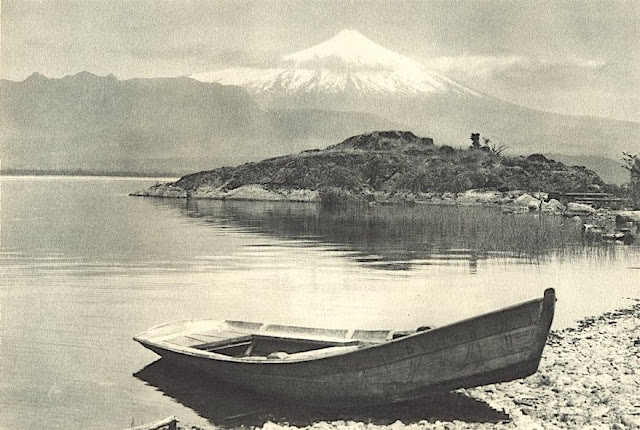Volcán San José (5,856m)
Chili - Argentine
Photographié en 1932 à bord d'un aéroplane
Le volcan
Le San José (5 856 mètres) est un volcan des Andes centrales
d'Argentine (province de Mendoza, Tunuyán) et du Chili (Région
métropolitaine de Santiago).
Il est situé à 40 kilomètres au sud du
volcan Tupungato, à quelque 80 kilomètres à l'est-sud-est de Santiago du
Chili, et à 80 kilomètres à l'ouest de la ville argentine de San
Carlos.
Son altitude est de (sommet sud-oriental) et 5 820 mètres (sommet sud-occidental).
Le
volcan comporte plusieurs sommets secondaires. La première ascension du
sommet nord du San José date de l'année 1920 (5 740 mètres). C'est en
1931, qu'Otto Pfnninger et Sebastián Krückel surmontèrent le sommet
principal (sommet sud-est). Ils furent surpris de découvrir l'importance
du cratère et des glaciers qui occupaient l'intérieur de ce dernier.
À
3 130 mètres d'altitude se trouve le refuge refugio Plantat, qui fut
édifié en par Enrique Plantat en 1937, utilisant les plans d'un refuge
déjà existant dans les Alpes. Au début, il était pourvu d'eau potable et
de chauffage ainsi que d'autres commodités, mais il s'est dégradé faute
d'entretien.
Lorsqu'on aborde le volcan du côté chilien, près de la
localité de San Gabriel, il surprend par son énorme taille et contribue à
impressionner les touristes.
Le photographe
Robert
Gerstmann fut un photographe très connu en Amérique du Sud. Gerstmann
était un ingénieur électricien né à Vienne qui, dans sa jeunesse,
développa un intérêt pour la photographie. En 1924, il immigre au Chili
et de là se rend en Bolivie, où il réalise quelque 5 000 photographies,
dont une sélection apparaît sous forme de photogravures dans son
Bolivie, 150 Grabados en Cobre (1928), réédité en 1996 par la Fundación
Quipus en La Paz. Gerstmann a parcouru de longues distances,
photographiant l'altiplano de La Paz au sud jusqu'à la frontière
argentine, à l'ouest jusqu'à la frontière chilienne et à l'est jusqu'aux
Yungas, Cochabamba, Santa Cruz et les basses terres le long des Ríos
Beni et Mamoré. Seuls Tarija et le Chaco ont échappé à son objectif.
Cinq de ses photographies illustrent le magazine National Geographic
"The Heart of Aymara Land" de Stewart E. McMillan (février 1927), et
plusieurs apparaissent dans Bolivia (Guía Sinóptica) 1929 de
Gustavo-Adolfo Otero. Gerstmann s'installe à Santiago en 1929. Il publie
d'autres photos. albums, dont Chili : 280 grabados en cobre (1932),
Colombie : 200 grabados en cobre (1951) et Chili en 110 cuadros (1960
?), et s'est essayé au cinéma en Bolivie. On pense qu'il est mort à
Santiago ca. 1960. Plusieurs milliers de ses plaques de verre se
trouveraient dans une université d'Antofagasta.
________________________________________
2011-2024 - Gravir les montagnes en peinture
Un blog de Francis Rousseau



















